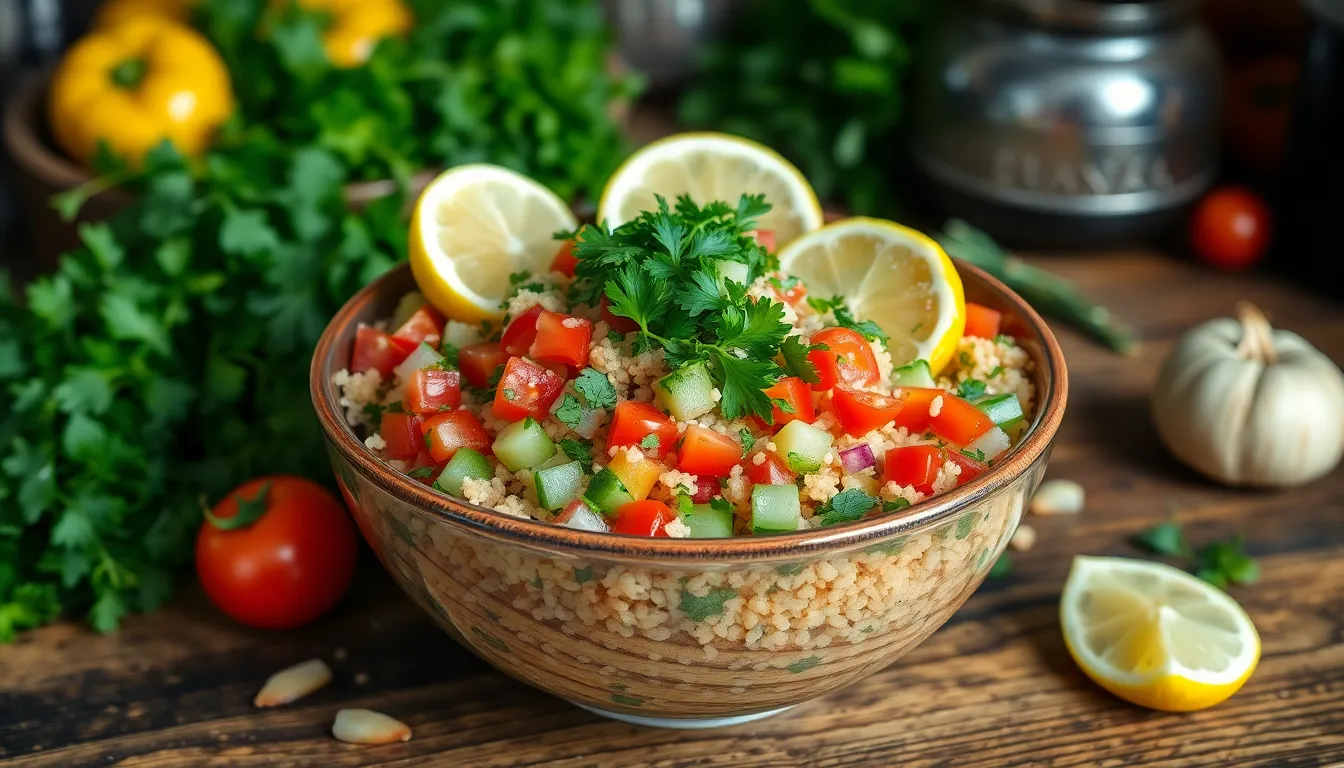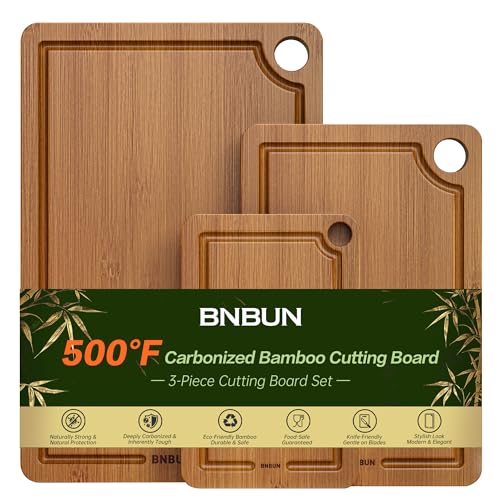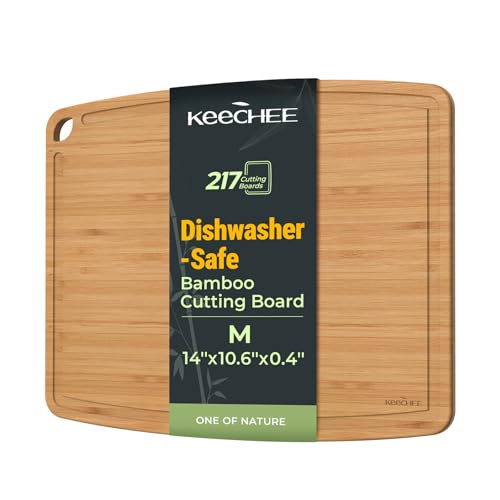Ingredients
This traditional tabbouleh recipe requires fresh and simple ingredients that create vibrant Mediterranean flavors. You’ll need to gather these components to build the authentic taste that makes this Lebanese salad so beloved.
Fresh Herbs
- 2 cups fresh flat-leaf parsley, finely chopped
- 1/4 cup fresh mint leaves, finely chopped
- 2 green onions, thinly sliced
Vegetables
- 3 medium tomatoes, seeded and diced
- 1 large cucumber, peeled and diced
- 1/2 medium red onion, finely diced
Grains and Pantry Items
- 1/2 cup fine bulgur wheat
- 1/4 cup fresh lemon juice
- 1/4 cup extra virgin olive oil
- 1 teaspoon salt
- 1/2 teaspoon black pepper
Equipment Needed

Making authentic tabbouleh requires minimal kitchen equipment that you likely already have in your pantry. Your success depends on having the right tools to properly prepare each ingredient and achieve the perfect texture.
Sharp chef’s knife serves as your most important tool for this recipe. You need precise cuts to finely chop the parsley and mint without bruising the delicate herbs. A dull blade will crush the leaves and release bitter juices that affect the final flavor.
Large cutting board provides ample workspace for handling the substantial amount of fresh herbs this recipe requires. Choose a board with enough surface area to spread out ingredients without overcrowding your preparation space.
Fine-mesh strainer becomes essential for rinsing the bulgur wheat thoroughly. This tool removes excess starch and prevents your tabbouleh from becoming mushy or sticky.
Medium mixing bowl accommodates all ingredients while leaving room for gentle tossing. The bowl should be large enough to mix everything without spilling but not so large that ingredients get lost at the bottom.
Small whisk or fork helps you create a smooth dressing by properly combining lemon juice and olive oil. This ensures even distribution of flavors throughout the salad.
Measuring cups and spoons guarantee accurate proportions of bulgur wheat, lemon juice, and olive oil. Precise measurements maintain the authentic balance of flavors that makes tabbouleh so distinctive.
Clean kitchen towels assist in drying washed herbs completely. Excess moisture dilutes the dressing and creates a watery texture that compromises the dish’s integrity.
Instructions

Follow these detailed steps to create authentic tabbouleh that captures the vibrant essence of Lebanese cuisine. Each stage builds upon the previous one to develop the perfect balance of fresh flavors and textures.
Prep the Bulgur
Rinse 1/2 cup fine bulgur wheat under cold running water using a fine-mesh strainer until the water runs clear. Place the rinsed bulgur in a medium bowl and pour 1 cup of boiling water over it. Cover the bowl tightly with plastic wrap or a clean kitchen towel and let it stand for 15 minutes until the bulgur absorbs the water completely. Fluff the bulgur with a fork after the soaking time and drain any excess water through the fine-mesh strainer. Pat the bulgur dry with clean kitchen towels and set aside to cool to room temperature.
Prepare the Vegetables
Wash 4 medium ripe tomatoes under cold water and pat them dry with paper towels. Remove the stems and cut each tomato in half horizontally. Gently squeeze out the seeds and excess juice over the sink. Dice the tomatoes into small 1/4-inch pieces and place them in a separate bowl. Wash 1 English cucumber thoroughly and peel it using a vegetable peeler. Cut the cucumber lengthwise and scrape out the seeds with a spoon. Dice the cucumber flesh into 1/4-inch pieces matching the tomato size. Combine the diced tomatoes and cucumber in a large mixing bowl.
Chop the Herbs
Wash 2 large bunches of fresh flat-leaf parsley under cold running water and shake off excess moisture. Pat the parsley completely dry using clean kitchen towels since any remaining water will make your tabbouleh soggy. Remove the thick stems and discard them while keeping only the leaves and tender stems. Finely chop the parsley using a sharp chef’s knife until you have about 2 cups of minced herbs. Wash 1/4 cup fresh mint leaves and dry them thoroughly before mincing them finely. Add both the chopped parsley and mint to the bowl with the vegetables.
Make the Dressing
Pour 1/4 cup fresh lemon juice into a small bowl and add 1/4 cup extra-virgin olive oil. Sprinkle in 1 teaspoon salt and 1/2 teaspoon freshly ground black pepper. Whisk the ingredients together using a small whisk or fork until the dressing emulsifies and appears smooth. Taste the dressing and adjust the seasoning by adding more lemon juice for tartness or salt for flavor enhancement.
Assemble the Tabbouleh
Add the cooled bulgur wheat to the bowl containing the chopped vegetables and herbs. Pour the prepared dressing over the mixture and toss everything together using clean hands or a large spoon. Mix thoroughly to ensure every ingredient gets coated with the lemon and olive oil dressing. Cover the bowl with plastic wrap and refrigerate for at least 30 minutes to allow the flavors to meld together. Taste and adjust seasoning with additional salt, pepper, or lemon juice before serving. Serve the tabbouleh chilled or at room temperature for the best flavor experience.
Tips for the Best Tabbouleh
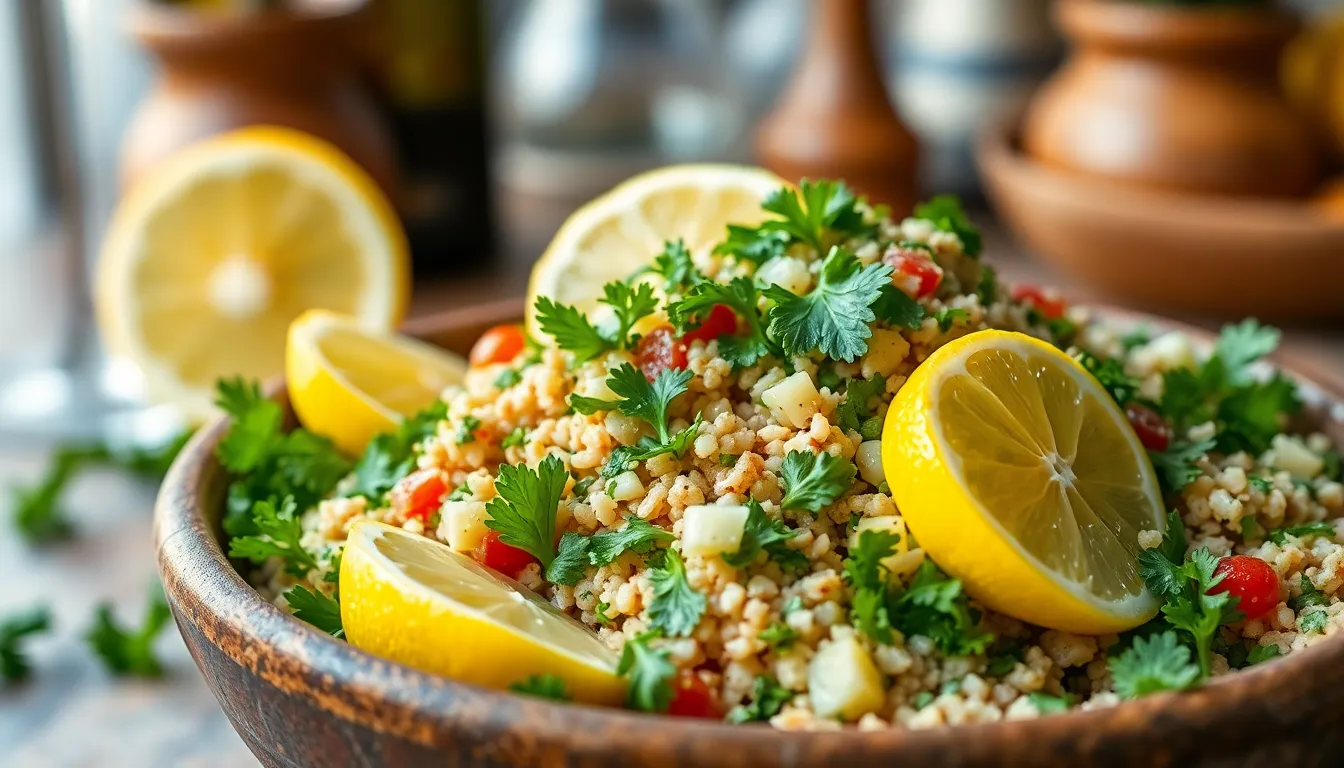
Master these essential techniques to create restaurant-quality tabbouleh that bursts with authentic Mediterranean flavors. Your attention to these details will transform a simple salad into an extraordinary culinary experience.
Choosing the Right Bulgur
Select fine-grain bulgur wheat for the most authentic texture and fastest preparation time. Medium-grain bulgur works as an alternative but requires longer soaking and produces a chewier consistency. Avoid coarse bulgur since it overwhelms the delicate herbs and creates an unbalanced dish.
Rinse your bulgur thoroughly under cold water until the water runs clear to remove excess starch and debris. This step prevents the final dish from becoming gummy or cloudy. Soak the rinsed bulgur in cold water for exactly 30 minutes to achieve the perfect tender yet firm bite that traditional tabbouleh demands.
Drain the soaked bulgur completely using a fine-mesh strainer and press out excess moisture with clean kitchen towels. Properly drained bulgur prevents your tabbouleh from becoming watery and maintains the fresh crispness of the other ingredients.
Herb to Grain Ratio
Prioritize fresh parsley as the dominant ingredient with a ratio of 3 cups chopped parsley to 1/2 cup prepared bulgur. This herb-forward approach creates authentic Lebanese tabbouleh where the bulgur serves as an accent rather than the main component. Many recipes incorrectly emphasize grains over herbs which diminishes the dish’s traditional character.
Add fresh mint sparingly at about 1/4 cup per recipe to complement rather than compete with the parsley’s brightness. Too much mint overpowers the other flavors and creates an unbalanced taste profile. Chop both herbs finely but avoid over-processing them into a paste-like consistency.
Remove thick stems from parsley before chopping to prevent bitter flavors and tough textures. Pat herbs completely dry after washing to maintain the salad’s fresh appearance and prevent diluting the lemon-olive oil dressing.
Storage and Serving
Store tabbouleh in the refrigerator for up to 3 days in an airtight container to maintain freshness and prevent contamination. The flavors actually improve after the first day as the ingredients meld together and the bulgur absorbs the dressing completely.
Serve tabbouleh chilled or at room temperature for the best flavor experience. Cold temperatures mute the herb’s brightness while room temperature allows all the Mediterranean flavors to shine through. Remove the dish from refrigeration 15-20 minutes before serving for optimal taste.
Garnish with additional lemon wedges and drizzle extra olive oil just before serving to refresh the flavors. Accompany with crisp romaine lettuce leaves or pita bread triangles for authentic Lebanese presentation and added textural contrast.
Variations
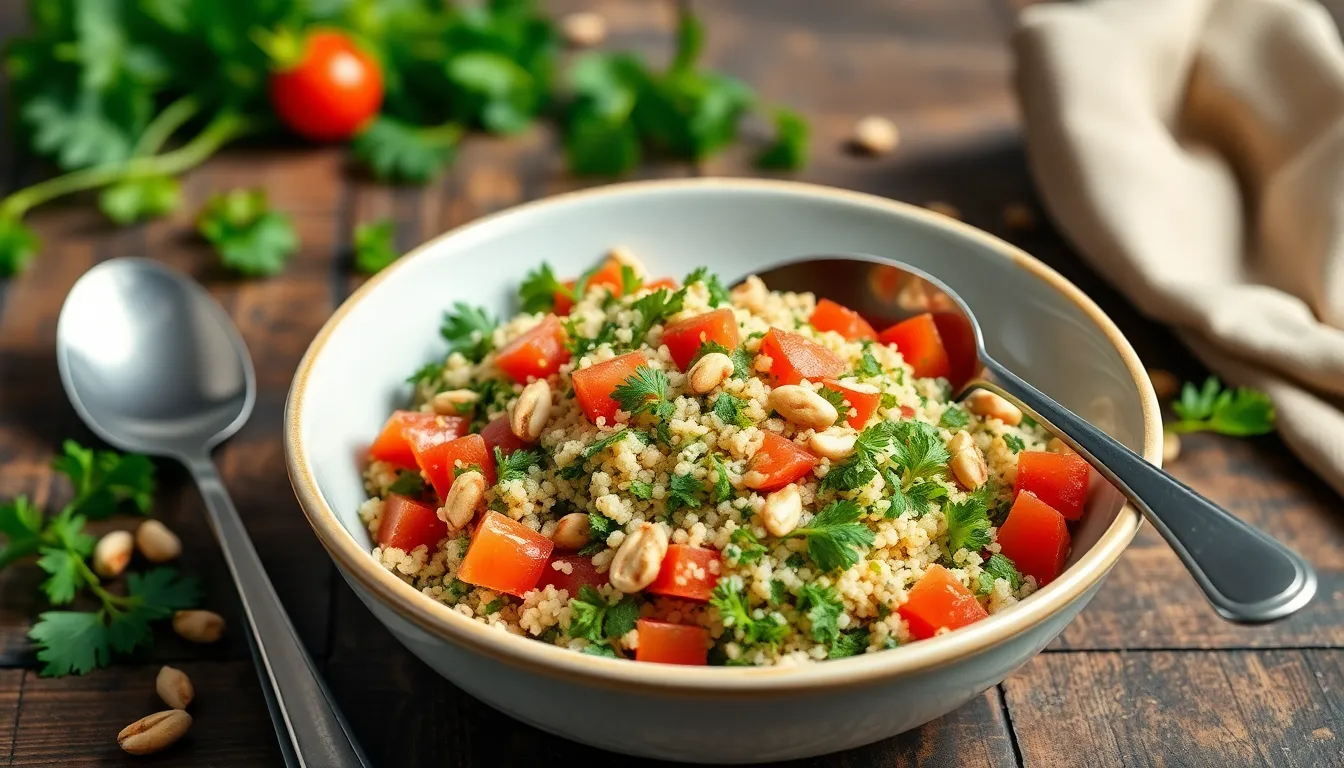
You can adapt this classic tabbouleh recipe to suit different dietary preferences and regional styles. Each variation maintains the fresh Mediterranean spirit while offering unique flavors and textures.
Lebanese Style Tabbouleh
Traditional Lebanese tabbouleh emphasizes the herb content over grains, creating a lighter and more vibrant dish. You should use 4 cups of finely chopped fresh parsley instead of the standard 3 cups, while reducing the bulgur to just 1/4 cup. This version requires extra mint – about 1/2 cup instead of 1/4 cup – to achieve the authentic Lebanese flavor profile.
Add 1 medium finely diced onion and 2 additional tablespoons of lemon juice to brighten the overall taste. Lebanese cooks traditionally serve this version with crisp romaine lettuce leaves for scooping, making it perfect for sharing. The result delivers a more herbaceous and refreshing salad that showcases the parsley as the star ingredient.
Quinoa Tabbouleh
Replace the bulgur wheat entirely with 1 cup of cooked quinoa for a protein-rich alternative that appeals to health-conscious diners. Cook 1/2 cup of dry quinoa in 1 cup of vegetable broth until tender, then cool completely before mixing with the other ingredients.
This variation requires slightly more lemon juice – about 1/4 cup total – to balance the nuttier flavor of quinoa. You can add 1/4 cup of toasted pine nuts or chopped walnuts for extra texture and richness. The quinoa version provides complete proteins and works exceptionally well as a standalone meal rather than just a side dish.
Gluten-Free Options
Several grain alternatives work beautifully in gluten-free tabbouleh while maintaining the dish’s signature texture and taste. Cauliflower rice offers the closest texture match to bulgur – simply pulse 2 cups of cauliflower florets in a food processor until they resemble coarse crumbs.
| Grain Alternative | Quantity | Preparation Time | Flavor Profile |
|---|---|---|---|
| Cauliflower rice | 2 cups raw | 5 minutes | Neutral, light |
| Cooked millet | 1 cup | 20 minutes | Nutty, mild |
| Buckwheat groats | 3/4 cup cooked | 15 minutes | Earthy, robust |
| Brown rice | 1 cup cooked | 45 minutes | Chewy, hearty |
Millet provides a delicate texture similar to couscous and absorbs the lemon dressing beautifully. Raw cauliflower rice needs no cooking but benefits from a light salting and 10-minute rest to soften slightly. Each option maintains the fresh vegetable and herb balance that makes tabbouleh so appealing to different dietary needs.
Make-Ahead Instructions
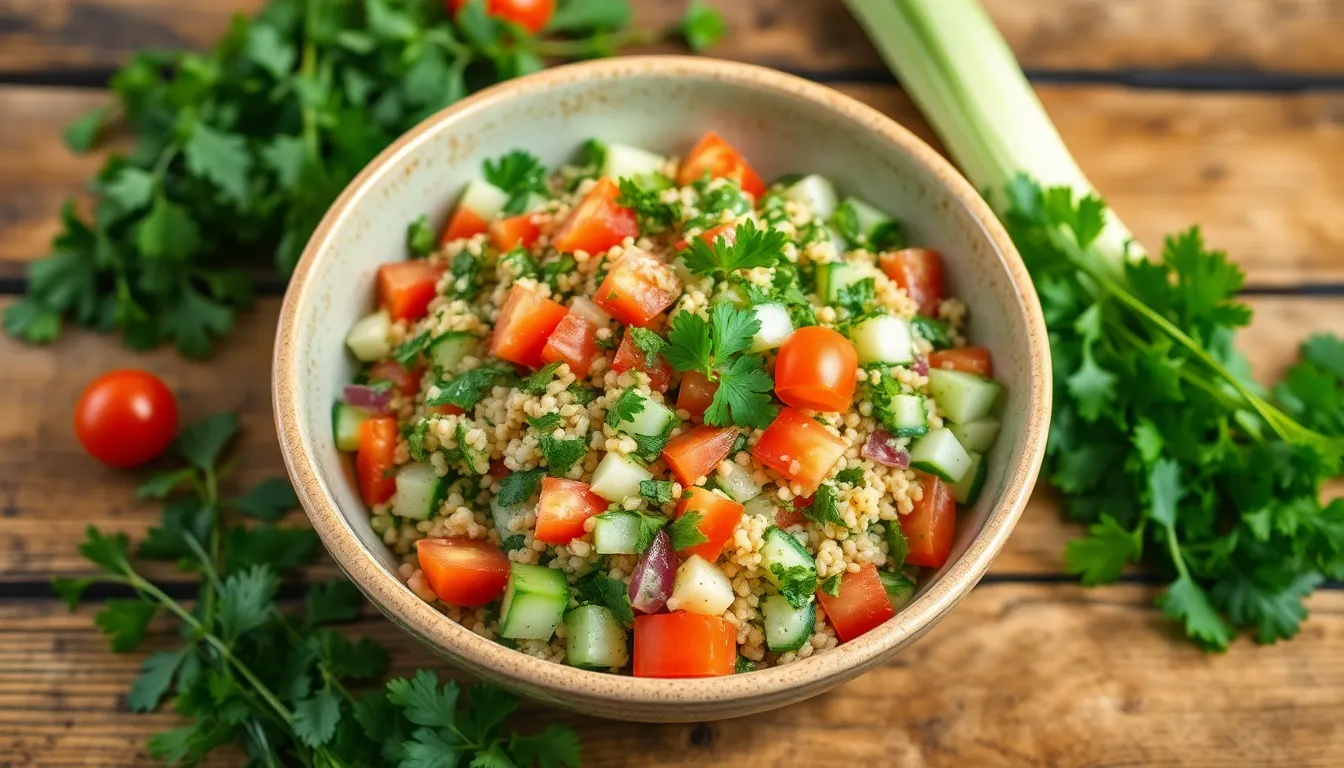
Your tabbouleh benefits significantly from advance preparation. This traditional salad actually improves in flavor when given time to rest in the refrigerator.
Day Before Serving
Prepare all components separately for optimal freshness. Rinse and soak your bulgur wheat according to package directions, then drain thoroughly and refrigerate in an airtight container. Dice your tomatoes and cucumbers, storing them in separate containers to prevent excess moisture transfer. Wash and finely chop your parsley and mint, then pat completely dry with clean kitchen towels before refrigerating in sealed containers.
Same Day Assembly
Combine your prepared ingredients 2 to 4 hours before serving for the best flavor development. Mix the bulgur, vegetables, and herbs in your large mixing bowl. Whisk together fresh lemon juice, olive oil, salt, and pepper, then toss with the salad ingredients. Cover tightly and refrigerate until ready to serve.
Storage Guidelines
| Timeline | Storage Method | Quality Notes |
|---|---|---|
| Up to 3 days | Airtight container in refrigerator | Flavors continue to improve |
| 2-4 hours | Covered bowl in refrigerator | Optimal flavor development |
| Day before | Separate containers for components | Maximum freshness maintained |
Your assembled tabbouleh keeps well for up to 3 days in the refrigerator. The flavors meld beautifully over time, making leftovers even more delicious than the first serving. Always taste and adjust seasoning before serving, as you may need additional lemon juice or salt after the resting period.
Remove your tabbouleh from the refrigerator 15 minutes before serving to bring it closer to room temperature. This allows the olive oil to flow freely and the flavors to open up completely.
Serving Suggestions
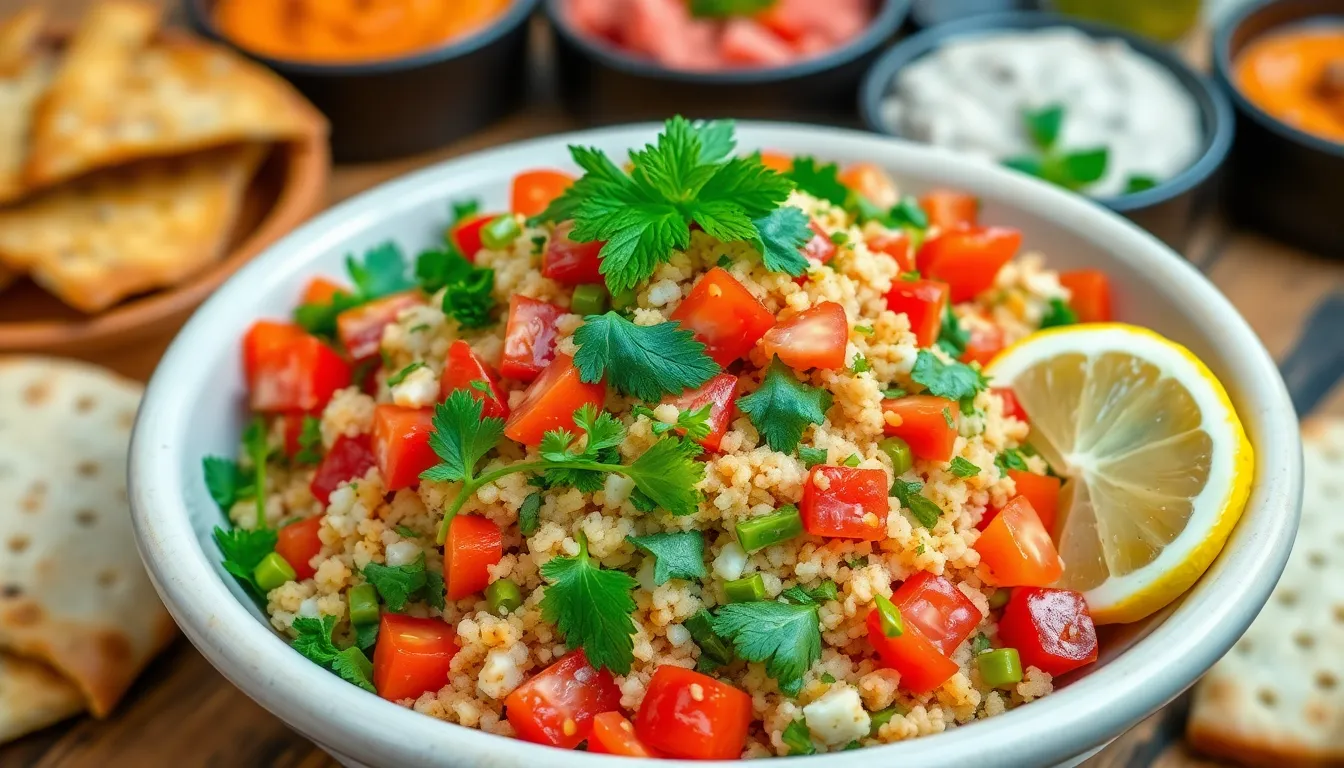
Your fresh tabbouleh transforms any meal into a Mediterranean feast when paired thoughtfully with complementary dishes. Serve this vibrant salad alongside grilled meats like lamb kebabs or chicken shawarma to create an authentic Middle Eastern dining experience. The herb-forward flavors balance perfectly with rich proteins while adding refreshing contrast to heavier dishes.
Traditional accompaniments enhance tabbouleh’s natural appeal. Warm pita bread provides the perfect vehicle for scooping up the grain and herb mixture. Crisp romaine lettuce leaves create elegant edible cups that showcase the colorful ingredients while adding satisfying crunch. Fresh cucumber rounds or endive leaves offer additional serving options for lighter presentations.
Mediterranean meze platters benefit tremendously from tabbouleh’s bright flavors. Arrange your chilled salad alongside hummus, baba ganoush, olives, and feta cheese for an impressive spread. Stuffed grape leaves, roasted red peppers, and fresh radishes complete the authentic Middle Eastern experience your guests will remember.
Main course pairings work beautifully with this versatile salad. Grilled fish like salmon or sea bass complement tabbouleh’s lemony dressing without overwhelming the delicate herb flavors. Roasted chicken or turkey provide protein-rich options that allow the parsley and mint to shine. Vegetarian meals featuring falafel or grilled halloumi cheese create satisfying combinations for plant-based dining.
Portion considerations ensure optimal enjoyment for your guests. Serve tabbouleh in individual bowls as a starter course, providing approximately 1/2 cup portions that whet appetites without being too filling. As a side dish, plan for 1/3 cup servings alongside heartier main courses. For light lunch presentations, generous 3/4 cup portions paired with warm pita create satisfying standalone meals.
Temperature preferences matter significantly for maximum flavor impact. Your tabbouleh tastes best when served slightly chilled or at room temperature, allowing all the Mediterranean flavors to develop fully. Remove the salad from refrigeration 15 minutes before serving for optimal taste. Avoid serving ice-cold tabbouleh as extreme temperatures mute the fresh herb and lemon flavors that make this dish special.
Conclusion
You’ve now mastered the art of creating authentic tabbouleh that rivals any restaurant version. This vibrant Lebanese salad transforms simple ingredients into something truly special with proper technique and timing.
Remember that patience pays off with tabbouleh—those flavors need time to meld and develop. Your efforts will be rewarded with a refreshing dish that’s perfect for any occasion.
Whether you stick to the traditional recipe or explore exciting variations you’ll have a versatile dish that keeps well and tastes even better the next day. Your guests will be impressed by the bright fresh flavors and your newfound Middle Eastern cooking skills.

